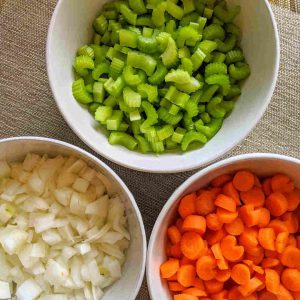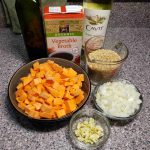Let’s talk about aromatics in cooking. Aromatics are vegetables that provide deep layers of flavor and aroma when chopped or crushed and then heated. They are the basis to an overwhelming variety of savory dishes. When a recipe starts with sautéing diced onions for a few minutes and then adding chopped garlic for another minute, that’s the aromatics.
There are many traditional aromatic combinations:
- Mirepoix is a classic aromatic combination in French cuisine. It uses a combination of onions, carrots and celery, usually in a ratio of 2:1:1.
- Italian cuisine has the same concept as mirepoix, but they call it soffritto. Most commonly mirepoix would be sautéed in butter where soffritto would be sautéed in olive oil. But the use of butter becomes more common in Northern Italy and the use of olive oil becomes more common in Southern France.
- Spanish cuisine has a sauce called sofrito (spelled with just one f and one t) which is made with onions, bell peppers, garlic and tomato.
- Germany has suppengrun, made from leeks, carrots, and celeriac (celery root).
- Cajun cuisine has its holy trinity of onions, celery, and green bell pepper.
- Myers+Chang refer to ginger, garlic and scallion referenced as the Asian trinity.
- The fragrant Thai soups, tom yum and tom kha, utilize galangal, lemongrass, and hot bird’s eye chili peppers.
All these named combinations have infinite variations. Ratios may differ, substitutions may be made, and additions of herbs and spices are common. Some of the variations also used often enough to garner a name. For example, if tomato paste is added to mirepoix late in the cooking process, it becomes pinçage. Generally, when a recipe calls for a tablespoon or two of tomato paste, it is not to bring a tomato flavor, but to provide umami.
My Take on Aromatics:
My take on aromatics is to be less tied to the exact recipe specifications, and more work with an understanding of their roll in the dish. The only aromatics that I always have in my pantry are yellow onions, garlic and ginger. I rarely make a special purchase to fill in the aromatic role in a recipe. Peppers, from the garden and the farmers’ market, in my fridge from mid-summer through late fall. When I make paella during that time frame, then peppers will be in the aromatics. But I’ll still make paella in the spring when I have no peppers. I’m also a big fan of incorporating stems into the aromatic stage of a recipe. If collards are going in the gumbo, finely chopped collard stems are going in the aromatics. Same for chard, beet greens and kale.
More Information:
The allium family botanically dominates culinary aromatics. Read more about them in All About Alliums.


